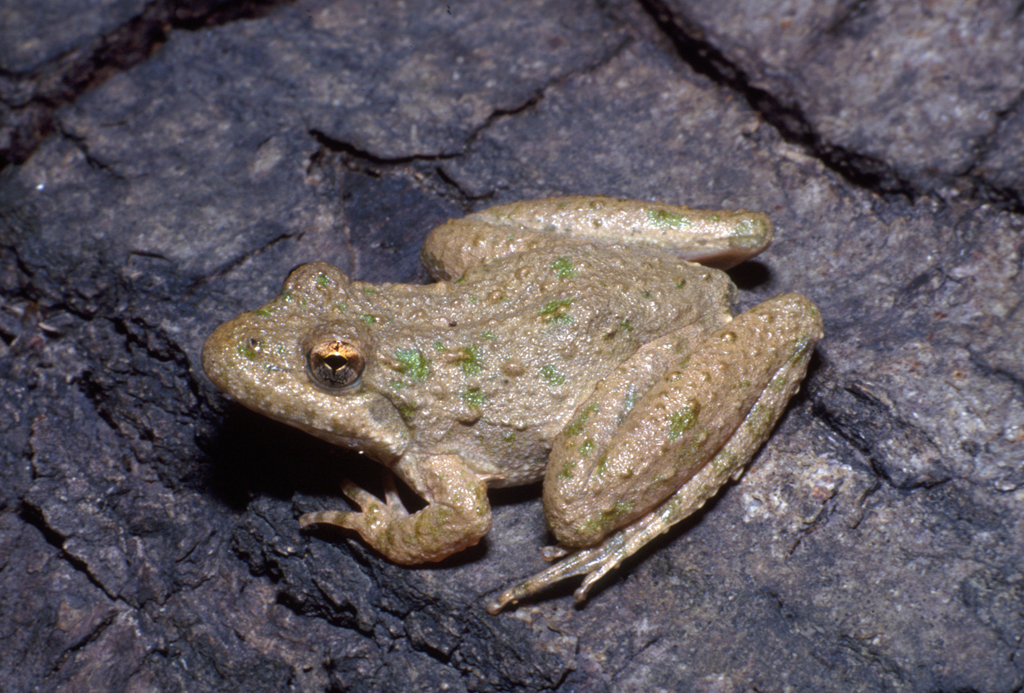
Declines in Great Lakes cricket frogs are thought to be a result of habitat destruction, pollution and competition from other frogs. Photo: Jim Harding
By KIMBERLY HIRAI
Capital News Service
LANSING – In 2006, Edythe Sonntag took off in her car in search of an amphibian no bigger than her thumbnail.
The Michigan State University doctoral student racked up 14,000 miles on her vehicle that summer, but Sonntag also got a better idea of how Blanchard’s cricket frog populations have declined over time.
She used the Michigan Frog and Toad Survey to help. The survey, along with other reports about historical populations, allowed Sonntag to visit each site where the frog had been documented.
April marks the 15th year that Michigan conservation officials will help residents conduct population surveys of the state’s 13 frog and toad species. Michigan’s survey began in 1996 with biologist Ray Rustem, who started a volunteer program to monitor them.
Every Great Lakes state conducts some form of annual frog and toad survey .
Scientific reports have documented amphibian declines in the United States since the 1980s. No universal factor has been identified as responsible for the declines, but scientists suspect habitat destruction or alteration, chemical pollution, amphibian diseases, climate change and others.
One to 50 volunteers are assigned to one of more than 400 routes across the state. Starting in April, volunteers—school classes, biologists and members of the public—visit their assigned areas three times throughout the breeding season. Species are identified by their distinct breeding calls between March and June, and volunteers train with a CD of the calls before taking a route.
Last year’s results show stable numbers, according to Lori Sargent, survey coordinator and endangered species specialist at the Department of Natural Resources and Environment.
“Most of the common ones are staying common and the rare ones are staying rare,” she said.
Although volunteers heard no Fowler’s toad calls last year, Sargent said the species is typically common and she’s not worried.
The survey is primarily used to indicate geographic locations where the department may not have a route or sites where additional surveying is needed to gain more information about species found there.
That’s the case for Fowler’s toad, Sargent said. Volunteers visit areas where frogs already have been heard, so other populations may exist in areas that aren’t along volunteers’ routes.
The survey also helps to identify future research projects on specific species and situations.
Sargent plans to suggest more specific research plans for Fowler’s toad this spring, in addition to new survey projects for all native amphibians that will focus on species that are harder to find and cover areas for which scientists have less data.
But Jim Harding worries about species like the Fowler’s toad, which is common in states to the east and south of Michigan.
“If any species is going to start disappearing because it gets a little bit dry or a little bit rough, that’ll be Fowler’s toad,” said the wildlife information specialist at the Michigan State University Museum.
In the state, its range has shrunk to the southern and western parts of the Lower Peninsula near Lake Michigan. The lake makes weather milder and creates more snow, providing greater insulation for the toads in winter.
As specialists—animals that require specific resources or environmental conditions to survive—species like Fowler’s toad may succumb to pressure first, Harding said.
Sonntag is trying to prevent such an adverse situation event for the cricket frog, which she says should maintain a place within its native habitat. After more than three years of study, she expresses an obvious affection for them.
“They’re small and they’re squishy, so they’re like the M&Ms of nature,” she said.
Despite their small size, Sonntag makes a big deal over their decline. Further surveys since 2006 have identified current populations as well as possible factors contributing to habitat loss and population decline.
One successful project rescued an established population from a condominium development site in Ypsilanti. State officials transferred the frogs to a remediated gravel pit near Port Huron on the St. Clair River. The population has lived there for five years.
Harding and Sonntag said the annual survey creates public awareness about amphibian populations and can indicate potential environmental hazards because amphibians are good indicators of water and environmental quality.
They also say habitat loss and land development are probably to blame for declines in Michigan, but Harding said scientists may never know the true status of Michigan’s frogs and toads or the natural fluctuations that occur because baseline data for them is unavailable.
Even so, the survey may lead to discovery of new populations.
For example, Sonntag said there are other populations of cricket frogs in Michigan—she’s found several without historical department records before.
“It’s just nobody’s been listening,” Sonntag said.
Kimberly Hirai writes for Great Lakes Echo.
© 2010, Capital News Service, Michigan State University School of Journalism. Not to be reproduced without permission.
Story as a Google Doc